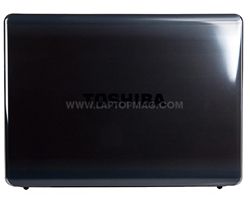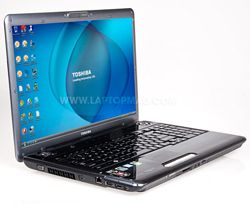Laptop Mag Verdict
This budget 17-incher offers a slick design, high-res display, and booming speakers for only $799.
Pros
- +
Slick design
- +
Bright, high-resolution display with good viewing angles
- +
Loud speakers
- +
USB ports can charge gadgets while the computer is off
- +
Strong wireless range
Cons
- -
Short battery life
- -
Comes with lots of trial software
- -
No Bluetooth option
Why you can trust Laptop Mag
We love nothing more than a budget notebook that doesn't look or feel like one. At $799, the Toshiba Satellite P305D-S8900 has a stylish design, a crisp 17-inch display, and good sound quality. The excessive amount of trialware and short battery life might turn some people off, but budget-conscious shoppers looking for a multimedia-centric desktop replacement won't be disappointed.
Design
Like other Satellite notebooks, including theM305DandA305, the P305D has Toshiba's Fusion finish. In a word, it's slick. Inside and out, it has a glossy black finish with a gold striped pattern stretching across. Even the touchpad has subtle stripes (albeit, in a black-on-black color scheme). Throughout, you'll also notice futuristic white LED lights: in addition to accents on the touchpad, palm rest, and front side is a panel of touch-sensitive multimedia controls above the keyboard, which responded to even the slightest tap.
At first glance, the glossy keyboard looks like it would be too slippery to type on, but our fingers settled comfortably on the keys. Although they have a plush shape, they barely make a sound. The keys also offered a good balance between sturdiness and comfort: we didn't notice any flex, but the keyboard panel didn't feel too rigid. Gamers will appreciate the full number pad to the right of the lettered keys.
In contrast to the rest of the chassis, the trackpad has a textured feel that makes it easy to move the cursor around with control. The rounded shape of the large silver buttons makes them comfortable to press; plus, they provide good tactile feedback and are relatively quiet, too. Although the touchpad's left-of-center placement looks awkward, it's in the middle of the keyboard (not including the number pad), which feels intuitive in practice.

Click to enlarge
At 7.2 pounds, this desktop replacement is lighter than it looks (some get into 8- and even 9-pound territory). The 15.7 x 11.4 x 1.5-inch body is compact enough to carry around the house; we just wish the glossy finish didn't pick up fingerprints.
Display
The 17-inch (1440 x 900) display looked bright and sharp when we watched an episode of Heroes on DVD. And considering the glossy finish, the viewing angles were good, too. We were able to tip the screen forward and watch from the sides with a comfortable view. In short, the display might not have the cinematic 16:9 aspect ratio that pricier multimedia machines have, or the sharper resolution of higher-end desktop replacements (1680 x 1050, 1920 x 1080), but the movie-watching experience is enjoyable nonetheless.
Sound
Compared with other budget notebooks, whose thin speaker strips are nothing to write home about, the P305D's Harman Kardon speakers are a true step up for multimedia junkies. When we watched movies and streamed music from Pandora, they produced loud, rich sound that didn't become distorted as we cranked the volume. Our only gripe: the speaker grilles' fan-like design detracts from the notebook's otherwise sleek looks.
Face Recognition and Webcam

Click to enlarge
The P305D comes with a 1.3-megapixel webcam and face-recognition software. Configuring the software was easy; just align your face with the cartoonish face on-screen (complete with eyes, a nose, and mouth), and move your head horizontally and vertically as instructed. The system registered our face on the first try, and the whole process took less than a minute.
By default, face recognition at logon is disabled; you'll have to enable it in the Toshiba Face Recognition settings. As for the webcam's quality, our still shots showed vibrant colors and brightness, and good-enough resolution.
Ports
In addition to three USB 2.0 ports and a USB/eSATA port, the P305D has S-Video and S/PDIF ports, FireWire, Ethernet and modem jacks, and headphone and mic ports. It also has an ExpressCard slot and a 5-in-1 memory card reader. We like that all of the ports are on the side and front of the notebook, although we would prefer it if the USB ports were closer to the back so that we could tuck our peripherals away more discreetly.

Click to enlarge

Click to enlarge
Like other Satellite notebooks, the USB ports feature Toshiba's Sleep-and-Charge technology, which means they can charge USB-powered gadgets even when the notebook is turned off. It works well--once you go into the settings and enable it. As always, we wish this nifty feature were ready to go out-of-the-box.
Performance
As the least expensive of Toshiba's three preconfigured P305 notebooks (the others start at $849 and $899), the P305D is the only one that runs on an AMD (as opposed to Intel) platform. On our most recent AMD-Intel face-off, AMD lagged behind Intel when it came to general performance and battery life, but its ATI graphics decisively trumped Intel's integrated solution.
The P305D has a 2.0-GHz AMD Turion X2 Dual-Core RM-70 CPU and 4GB of RAM, which added up to a PCMark Vantage score of 2,365, which is more than 1,000 points below average for desktop replacements. Even theSatellite L355D, another budget 17-incher that we reviewed last year, managed to score 36 points higher, despite having an older processor, 2GB of RAM, and a slow 4,200-rpm hard drive.
Before we pooh-pooh the P305D's performance too much, however, it's worth noting how much trial software comes preinstalled (see below for a full list). Out of the box, booting took 1 minute and 31 seconds; after removing all the bloatware, it took a reasonable 55 seconds. Moreover, once we removed all the excess baggage the PCMark Vantage score rose slightly to 2,398. However, the spacious 320GB, 5,400-rpm hard drive transferred 4.97GB of mixed media at a rate of 16.1 MBps, which falls below the category average of 21.7 MBps.
In our hands-on testing, the computer ran smoothly after we removed the trialware. Our DVD played without hiccups, even while we ran Windows Defender in the background. We also had no problem navigating between several open tabs in Internet Explorer--streaming Pandora and reading e-mails--while downloading Skype and running a virus scan.
Graphics
The P305's integrated ATI Radeon 3100 graphics card is sufficient for mainstream gaming, particularly at lower resolutions, but still falls short of the category average. Its 3DMark03 score (3,002) falls more than 10,000 points below average; its 3DMark06 score (1,292), more than 4,000 points below.
Granted, the desktop replacement category includes several gaming rigs, and many more machines with discrete graphics, so with that, the P305D didn't stand a chance. But even compared with more modestly configured desktop replacements, it's still at the bottom of the pack. The M305D, which had the same graphics card, managed near-identical scores on both benchmarks.
As for real-world performance, when set to autodetect settings (800 x 600-pixel resolution) the P305D managed an average of 30 frames per second in F.E.A.R., a graphically demanding game. When set to maximum settings (1440 x 900), the frame rate dropped to an unplayable 13 fps. So, hardcore gaming is out; mainstream games and everyday tasks should run fine.
Battery Life and Wi-Fi

Click to enlarge
Even for a desktop replacement, a category whose collective battery life is notoriously short, the P305 didn't last long: its six-cell battery died 1 hour and 49 minutes into our battery test, whereas the typical desktop replacement lasts an hour longer.
Since you're likely to keep this 7.2-pound notebook plugged in anyway, its strong wireless scores are more important: you can park the P305 far from your router and still surf the Web with ease. Its Atheros wireless-N radio delivered throughput of 20.2 Mbps and 18.7 Mbps at 15 and 50 feet, respectively, whereas the category average is 19.0 Mbps and 15.8 Mbps. Unfortunately, Bluetooth isn't an option on any of the three P305 configurations.
Software and Warranty
As mentioned above, the P305D comes with lots of trialware, which could explain its slow out-of-the-box boot time. Bundled software includes CyberLink PowerCinema, Ulead DVD MovieFactory, Microsoft Office Home and Student 2007 (60-day trial), PowerPoint Viewer 2007, Memeo AutoBackup, Symantec Norton 360, and QuickBooks Financial Center.
The P305D comes with a one-year warranty for parts and labor and the battery, including 24/7, toll-free phone support--standard for a consumer notebook.
Toshiba Satellite P305 Verdict
After we removed some software, we warmed to the Toshiba Satellite P305D-S8900. Its performance jumped, making the $799 price a bargain. Add to that a bright, high-res display, booming speakers, attractive design, face recognition, and Sleep-and-Charge USB ports, and you've got a desktop replacement that we'd easily recommend for those on a budget.
Toshiba Satellite P305D-S8900 Specs
| Brand | Toshiba |
| CPU | 2.0-GHz AMD Turion X2 Dual-Core RM-70 |
| Card Slots | 5-1 card reader, ExpressCard |
| Company Website | http://www.toshibadirect.com |
| Display Size | 17.1 |
| Graphics Card | ATI Radeon 3100 |
| Hard Drive Size | 320GB |
| Hard Drive Speed | 5,400rpm |
| Hard Drive Type | SATA Hard Drive |
| Native Resolution | 1440x900 |
| Operating System | MS Windows Vista Home Premium |
| Optical Drive | DVDRW |
| Optical Drive Speed | 6X |
| Ports (excluding USB) | Microphone, Kensington Lock, Headphone, USB/eSATA, Firewire, S/PDIF, Ethernet, S-Video, Modem |
| RAM | 4GB |
| RAM Upgradable to | 4GB |
| Size | 15.7 x 11.4 x 1.5 inches |
| USB Ports | 3 |
| Video Memory | 256MB |
| Warranty/Support | One-year parts-and-labor, one-year battery/24/7 toll-free phone |
| Weight | 7.2 pounds |
| Wi-Fi | 802.11b/g/n |
Most Popular

